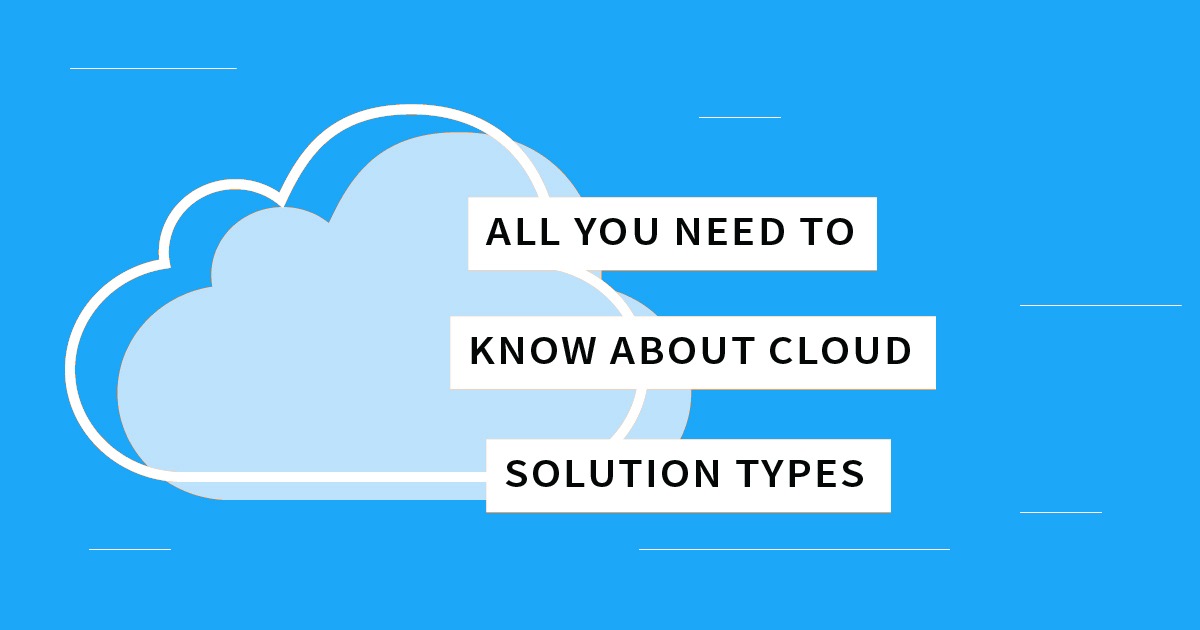
Types of Cloud Computing Solutions – Explained with Easy Instances
Cloud computing can get very complex and overwhelming if you don’t understand the specifics. However, we try to explain different types of cloud computing solutions in a very simple way.
Broadly, there are basically three types of cloud computing solutions:
1. IaaS – First level – Basic infrastructure
2. PaaS – Second level – Built on IaaS
3. SaaS – Last level – For end users
Infrastructure-as-a-Service (IaaS)
The first level of hierarchy in cloud computing is IaaS. All other services and applications are built on top of infrastructure.
The basics of building an application, which is often available in the stack form, can be classified under the IaaS category. A provider that offers IaaS services would provide prebuilt hardware like Virtual Machines, Storage Space, Network, and Web Server.
Other applications and services like OSes are developed on top of the basic infrastructure i.e. IaaS. In simple words, IaaS is the first building block of cloud computing hierarchy.
IaaS examples:
Azure stack, Amazon EC2, Google Compute Engine, Rackspace
IaaS explained with a general example
Consider an example of building a hotel. IaaS would be like getting a hotel site with the building foundation built out, roads and utilities to the site in working condition, and all building materials (steel, beams, columns, cement, doors, windows, elevators, doors, pipes, electrical cables) laid out in silos to purchase and implement in construction. This material is made available to you at a price. You can use specialized labor to build a hotel.
Similarly, the basic infrastructure such as VM, storage, server, network is made available to you from an IaaS provider. You would need system architects and administrators to put all the pieces together and install software licenses.
When is IaaS suitable for you?
If you have a complex custom IT implementation that you are migrating to the Cloud, IaaS approach is suitable for you as you can build your infrastructure from scratch just like you want it.
Platform-as-a-Service (PaaS)
PaaS is just one step beyond IaaS, including the services such as OSes, middleware, runtimes that can be built on top of the infrastructure. The services and applications are basically platforms – that are further used to host software application on top of them.
PaaS and IaaS are closely related to each other. Sometimes, there can be confusion whether a service falls under IaaS or PaaS because the practical definition is very fluid. If the component is the first-level infrastructure and in stack form, it can be qualified as IaaS. The second level infrastructure which serves
as a platform to host final software is categorized as PaaS. Most of the operational middle infrastructure which is already built on top of basic infrastructure can be called as platform.
PaaS examples: Azure Websites, Google App Engine, AWS Beanstalk, Apache Stratos, OpenShift
Examples of PaaS: Azure Apps, AWS Elastic Beanstalk, Heroku, Apache Stratos, Google App Engine
PaaS explained with a general example:
Let’s take our hotel construction example. PaaS is like getting a ready-made hotel building, with utilities, elevators, floors, and rooms. You have a ready-to-go hotel that can be operational with minimum changes. You also have the choice to customize your hotel the way you want. Design and add furniture, electronics, sheets, towels, and decorations to suit your requirement. This provides a platform for you to complete the hotel, so that guests can use the hotel.
Similarly, PaaS comes with pre-built platform that may include pre-installed OS and services which you can populate with your data and applications. You have less requirement of system architects, but you still need system administrators.
When is PaaS suitable for you?
If you are into development who want to focus on building the app rather than managing basic infrastructure, PaaS is the most suitable cloud computing technology for you.
Software-as-a-Service (SaaS)
SaaS is usually the last stage of cloud computing hierarchy where the end users are involved. Being a widely used distribution model, SaaS is the obvious choice for business that want to outsource almost everything related to cloud IT management. SaaS includes management of IaaS and PaaS as well.
If you want to use software that is fully managed in the backend by a third-party vendor like Apps4Rent, SaaS is the right cloud computing choice for you.
SaaS examples:
Office 365, Google Suite, Salesforce, Dropbox, HubSpot, Mailchimp, Zendesk, Slack
SaaS explained with a general example
Once the hotel is constructed, it is only of value when the guests arrive. Similarly, the software/application is required to be put on the platform dealt in the PaaS stage. Software as a Service is like renting a room in a hotel. Just like guests in the hotel don’t worry about how the hotel was built, the end users of the software don’t care about platform or infrastructure, if the service is fine.
When is SaaS suitable for you?
If you are the end user who wants the software like Office, CRMs, emails to work fine without bothering about the technology behind it, SaaS is the suitable choice.
Here’s the table that shows the comparison between IaaS vs PaaS vs SaaS:
| Components | Managed by IaaS provider |
Managed by PaaS provider |
Managed by SaaS provider |
|
| Application | Software | ✔ | ||
| Data | ✔ | |||
| Runtime | Platform | ✔ | ✔ | |
| Middleware | ✔ | ✔ | ||
| Operating System | ✔ | ✔ | ||
| Virtual Machine | Infrastructure | ✔ | ✔ | ✔ |
| Server | ✔ | ✔ | ✔ | |
| Storage | ✔ | ✔ | ✔ | |
| Network | ✔ | ✔ | ✔ |
You can incorporate any of the above cloud computing technologies depending on your business requirements. If you are not able to decide the right solution for your business, contact our experts now!
